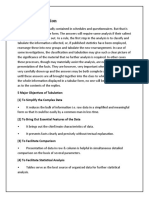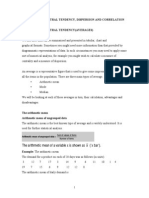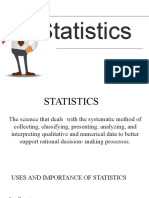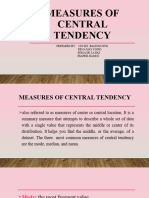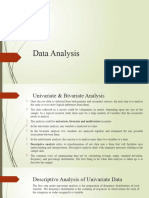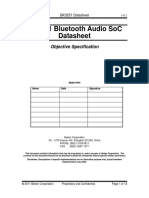Lesson 3 Edtech
Lesson 3 Edtech
Uploaded by
api-268563289Copyright:
Available Formats
Lesson 3 Edtech
Lesson 3 Edtech
Uploaded by
api-268563289Original Title
Copyright
Available Formats
Share this document
Did you find this document useful?
Is this content inappropriate?
Copyright:
Available Formats
Lesson 3 Edtech
Lesson 3 Edtech
Uploaded by
api-268563289Copyright:
Available Formats
Statistics
Module 10
1
Lesson 3
Measures of Central Tendency of Group Data
Learning Objectives: Upon the successful completion of this lesson, students will be able to:
Identify the property of central tendency for grouped data
Interpret the difference among various measures of central tendency such as mean,
median and mode
Calculate and interpret the value of mean, median and mode of grouped data
Calculate and interpret the weighed mean
Identify distribution as symmetrical or skewed
Statistical techniques were used to analyse and present data, provide for making
decisions under any management method. In order to turn raw data into meaningful
numbers, an understanding of statistical measures that boil down complicated data into
a value that is understandable and relevant is essential. Theses lesson presents some
important measures to be considered under grouped data.
3.0 Measures of Central Tendency
There are three measures of central tendency- the mode, median and the
arithmetic mean. The measure that is most appropriate in any particular situation
depends on the level of measurement of data, the information that one wishes to
communicate about the data and the way data are concentrated in the data set.
The mode, median and mean each present the datas central value. Under
certain conditions, these three measures can be the same. Most often, they are not.
Statistics
Module 10
2
Although this sounds confusing, the explanation is that each of these summary statistics
has its own definition. To use these measures effectively then, one must understand the
perspective that each measures presents, as well as the advantage and disadvantage
associated with each measure.
Briefly, for the mode, the distributions center is the data point or score that
occurs most frequently in the distribution. For the median, the distributions center is the
value that evenly divides the distribution it is the value or score below or above which
50% of the observations occur. Then mean, the distributions center is the balance
point of the distribution, which is based on considering the size or weight of each data
point.
3.1 Mode
The mode of a data set is the value/ values occurring most often in the
distribution. The mode identifies the distributions most prevalent score/scores. For
example, in the data set { 1, 1, 2, 3, 4}, the mode is 1 because 1 is the value that occurs
most frequently. In the data set { 4, 4, 4, 5, 6, 6, 6}, there are two modes: 4 and 6. In
this example, both 4 and 6 occur three times in the distribution, which is most frequently
than any other value occurs. Because this data set has two modes, it is called bimodal.
The mode is a crude but simple measure of central tendency. It can be applied to
nominal, ordinal, interval and ratio scale data, but usually it is applied only to nominal
data. In practice, the mode is not used with ordered, interval or ratio scale data, even
though it is permitted.
Statistics
Module 10
3
Advantages and Disadvantages of Mode
Typically a number that actually occurs in dataset
Has highest probability of occurrence
Applicable to nominal as well as ordinal, interval and ratio scales
Unaffected by extreme scores
But not representative if multimodal with peaks far apart
3.2 The Median
The median of a data set is the number that divides the distribution exactly in
half. That is, when the distributions scores are arranged from smallest to largest, the
median is the midpoint value of the data set. This means that one-half or 50% of the
data scores are larger than the median value and one-half or 50% are smaller than the
median value.
The median is an appropriate measure for ordinal, interval and ratio scale data. It
is inappropriate for nominal scale data, however, because nominal scale data cannot be
ranked. The median always expressed in the same units as the original data. Further,
unlike the mode, the median always have a single value. That is, a data set cannot have
more than one median.
To calculate the median for a grouped data set, lets take this example: suppose
a librarian wishes to determine the median time required for interlibrary loan personnel
to fill requests. To begin the analysis, the librarian examines the number of requests
and then prepares a frequency distribution as shown in the table.
Statistics
Module 10
4
Each of these 156 records contains the clerks notation of the number of days
required to fill the request (a designation of zero day means that the request was filled
on the day it was received). Since the frequency distribution does not show the raw data
values for the distribution, the librarian cannot list the actual values included in the class
interval that contains the median. Because of this, the librarian must determine the
median through a method known as interpolation.
In the table, n=156. So, the rank of the median lies midway between the 78
th
and
79
th
scores. The frequency distribution shows that this score is contained in the interval
whose real limits are 7.5 to 11.5. the 78
th
item is the sixth element in the median class
[6=78-72]. Thus, to arrive at the desired 78
th
rank, the librarian must determine the value
of going six steps into the interval 7.5 to 11.5.
Table 3.1 Summary of Days required to fill Interlibrary Loan [n=156]
Class Interval
Frequency (f)
Upper Class
Boundary
Cumulative
frequency
0-3
4-7
8-11
12-15
16-19
20-23
24-27
24
48
40
15
14
9
6
3.5
7.5
11.5
15.5
19.5
23.5
27.5
24
72
112
137
141
150
156
n= 156
Because the interval contains 40 steps, since f =40, the median must lie 6/40 of
the way between 7.5 to 11.5, the calculations are as follows:
Statistics
Module 10
5
= 7.5 +
(11.5-7.5)
=7.5 + 0.15(4.0)
=7.5 + 0.6 which is 8.1 days.
Formula shortens the calculations needed to compute the median for grouped data.
The symbol
is read X-tilde. As shown:
L +
F)
where L= lower class boundary of the median class
n= total number of observation in the data set
F= cumulative frequency up to, but not including the median class
f= frequency of the median class
w= size of the median class
Advantages and Disadvantages of Median
Also unaffected by extreme scores
Usually its value actually occurs in the data
But cannot be entered into equations because there is no equation that defines it
And not as stable from sample to sample because dependent upon the number
of score in the sample.
Statistics
Module 10
6
3.3 The Mean
The arithmetic mean, popularly called the average of the mean is a measure
familiar to most everyone. If data are organized in a grouped frequency distribution, the
mean is determined by multiplying the class midpoint of each class interval by the
frequency of observation in that class. These products are then totalled and divided by
the number of observations in the distribution. In mathematical terms, this is expressed
in formula:
=
where f= frequency or number of observations in each class
M= class midpoint for each class interval
k= number of classes
Formula can be illustrated using the book copyright data in the table,
organized in a group frequency distribution of 8 classes (k=8).
Statistics
Module 10
7
Table 3.2 Copyright Dates (n=100)
Interval
Frequency
(n)
Midpoint
(M)
Frequency x
midpoint
(n*M)
66-69
70-73
74-77
78-81
82-85
86-89
90-93
94-97
10
13
14
15
16
13
11
8
_______
n= 100
67.5
71.5
75.5
79.5
83.5
87.5
91.5
95.5
675.0
929.5
1,057.0
1,192.5
1,336.0
1,337.5
1,006.5
764.0
______
Sum= 8,298.0
From the table 3.2, the librarian sees the following values:
f
1
= 10
f
2
= 13
f
3
= 14
f
4
= 15
f
5
= 16
f
6
= 13
f
7
= 11
f
8
= 8
____
100
M
1
= 67.5
M
2
= 71.5
M
3
= 75.5
M
4
= 79.5
M
5
= 83.5
M
6
= 87.5
M
7
= 91.5
M
8
= 95.5
=f
1
+f
2
+f
3
+f
4
+f
5
+f
6
+f
7
+f
8
=10 + 13 + 14 + 15 + 16 + 13 + 11 + 8 which is 100
Now, substituting into formula with k=8,
Statistics
Module 10
8
=
()()()()()
which is 80.98 or 81.
Since the data are discrete, the mean is rounded to 81. This statistic tells the librarian
that the average copyright date of the 100 books in the study is 1981. Excluding a rare
book or achieve collection, this statistic confirms that the book in the study are old by
todays date.
Advantages and Disadvantages of Mean
Defined algebraically
Stable from sample to sample
But usually does not actually occur in the data
And heavily influenced by outliers
You might also like
- Practical Engineering, Process, and Reliability StatisticsFrom EverandPractical Engineering, Process, and Reliability StatisticsNo ratings yet
- YSMAN067 Anglais Rév.1 (Hema Star II Service)Document33 pagesYSMAN067 Anglais Rév.1 (Hema Star II Service)Eslam Maher100% (1)
- Basic Concepts in StatisticsDocument40 pagesBasic Concepts in StatisticsJeffrey CabarrubiasNo ratings yet
- Learning Activity 1 JigsawDocument15 pagesLearning Activity 1 Jigsawapi-321582699No ratings yet
- Q No#1: Tabulation: 5 Major Objectives of Tabulation: (1) To Simplify The Complex DataDocument13 pagesQ No#1: Tabulation: 5 Major Objectives of Tabulation: (1) To Simplify The Complex Datasami ullahNo ratings yet
- Q No#1: Tabulation: 5 Major Objectives of Tabulation: (1) To Simplify The Complex DataDocument13 pagesQ No#1: Tabulation: 5 Major Objectives of Tabulation: (1) To Simplify The Complex Datasami ullah100% (1)
- Unit 3 - Measures of Central TendencyDocument15 pagesUnit 3 - Measures of Central TendencyPrevenaManiamNo ratings yet
- Mean, Median & Mode PDFDocument11 pagesMean, Median & Mode PDFwolfretonmaths100% (1)
- Measures of Central TendencyDocument24 pagesMeasures of Central TendencyJoshua RaninNo ratings yet
- Mathematics in The Modern WorldDocument50 pagesMathematics in The Modern WorldCharlie Sambalod Jr.No ratings yet
- ASSIGNMEN4Document15 pagesASSIGNMEN4Harshita Sharma100% (1)
- Measures of Central Tendency Dispersion and CorrelationDocument27 pagesMeasures of Central Tendency Dispersion and CorrelationFranco Martin Mutiso100% (1)
- 02 Descriptive StatisticsDocument30 pages02 Descriptive StatisticsWahyu AdilNo ratings yet
- CHAPTER THREEDocument24 pagesCHAPTER THREEHabtamu SntayhuNo ratings yet
- Basics of Statistics: Definition: Science of Collection, Presentation, Analysis, and ReasonableDocument33 pagesBasics of Statistics: Definition: Science of Collection, Presentation, Analysis, and ReasonableJyothsna Tirunagari100% (1)
- BiostatisticsDocument23 pagesBiostatisticsHansa BorichaNo ratings yet
- A. Statistics - Information On The ProjectDocument15 pagesA. Statistics - Information On The ProjectAMIE ELCIT JOSE 20212065No ratings yet
- Mmw StatisticsDocument50 pagesMmw Statisticsgabrielcanam838No ratings yet
- State9 Project Work Statistics PDF May 24 2012-5-25 PM 1 8 Meg EvoziDocument27 pagesState9 Project Work Statistics PDF May 24 2012-5-25 PM 1 8 Meg EvoziMuhammadHazran100% (1)
- FROM DR Neerja NigamDocument75 pagesFROM DR Neerja Nigamamankhore86No ratings yet
- Research 8 Grade 8 Melc 1 q4 Week1Document26 pagesResearch 8 Grade 8 Melc 1 q4 Week1iancyrillvillamer10No ratings yet
- Probability & Statistics BasicsDocument30 pagesProbability & Statistics BasicsMandeep JaiswalNo ratings yet
- Notes Stats Unit1Document42 pagesNotes Stats Unit120BCS2512 Yashendra RajputNo ratings yet
- Add Math - AimanDocument9 pagesAdd Math - AimanAiman AzaharNo ratings yet
- 3.0 Measures of Central Tendency.Document12 pages3.0 Measures of Central Tendency.kennedy majakaNo ratings yet
- Module 5Document74 pagesModule 5Jessa Bell Cuales0% (1)
- StatisticsDocument211 pagesStatisticsHasan Hüseyin Çakır100% (6)
- Descriptive StatisticsDocument38 pagesDescriptive StatisticsHAPPY PHIRINo ratings yet
- Prelim Lec 2017Document49 pagesPrelim Lec 2017Marc AlamoNo ratings yet
- Measure of Central Tendency: Measure of Location: GoalsDocument7 pagesMeasure of Central Tendency: Measure of Location: GoalsDebashish MahapatraNo ratings yet
- 1 - Descriptive Statistics Data: Frequency DistributionDocument57 pages1 - Descriptive Statistics Data: Frequency DistributionspecialityNo ratings yet
- Claudia-3m CorrectedDocument34 pagesClaudia-3m CorrectedLeoncio LumabanNo ratings yet
- 2.1 Measures of Central TendencyDocument32 pages2.1 Measures of Central Tendencypooja_patnaik237No ratings yet
- Meharaj Khan (BS)Document7 pagesMeharaj Khan (BS)RebelNo ratings yet
- Basic StatisticsDocument52 pagesBasic StatisticsKrishna Veni GnanasekaranNo ratings yet
- The Measures of Central TendencyDocument26 pagesThe Measures of Central TendencytojiflmsNo ratings yet
- 2.central Tendency and DispersionDocument114 pages2.central Tendency and DispersionMohi SharmaNo ratings yet
- RESEARCHDocument15 pagesRESEARCHJerwin SanchezNo ratings yet
- Ken Black QA 5th Chapter 3 SolutionDocument47 pagesKen Black QA 5th Chapter 3 SolutionRushabh VoraNo ratings yet
- MeasuresDocument8 pagesMeasureswhitekaisuNo ratings yet
- المحاضرة رقم 3Document44 pagesالمحاضرة رقم 3د.م. حيدر كاظم زغير الجبوريNo ratings yet
- Research 3 Quarter 3 - MELC 1 Week 1-2 Inferential StatisticsDocument39 pagesResearch 3 Quarter 3 - MELC 1 Week 1-2 Inferential StatisticsHanna nicole JapsayNo ratings yet
- X X X X N X N: 1. Discuss/define Three Measures of Central TendencyDocument7 pagesX X X X N X N: 1. Discuss/define Three Measures of Central TendencyPandurang ThatkarNo ratings yet
- Ders 3-4 Descriptives of StatisticsDocument31 pagesDers 3-4 Descriptives of Statisticssametast1776No ratings yet
- Basic StatisticsDocument73 pagesBasic Statisticsartee_aggrawal4312100% (8)
- Statistical Analysis_ Descriptive Stat (2)Document6 pagesStatistical Analysis_ Descriptive Stat (2)henthent1No ratings yet
- Measures of Central TendencyDocument30 pagesMeasures of Central TendencyYukti SharmaNo ratings yet
- Application of Statistics in Different FieldsDocument30 pagesApplication of Statistics in Different FieldsAngelica Estacion100% (1)
- Measures of Central Tendency and DispersionDocument9 pagesMeasures of Central Tendency and DispersionAlduin04No ratings yet
- Measures of Central TendencyDocument49 pagesMeasures of Central TendencyCecile Cataga BalingcongNo ratings yet
- Section 2 Part 1Document25 pagesSection 2 Part 1Trisha ROQUENo ratings yet
- Mba Semester 1 Mb0040 - Statistics For Management-4 Credits (Book ID: B1129) Assignment Set - 1 (60 Marks)Document10 pagesMba Semester 1 Mb0040 - Statistics For Management-4 Credits (Book ID: B1129) Assignment Set - 1 (60 Marks)amarendrasumanNo ratings yet
- Assignment#8614 2Document37 pagesAssignment#8614 2maria ayubNo ratings yet
- Data Analysis RMDocument21 pagesData Analysis RMranisweta6744No ratings yet
- List The Importance of Data Analysis in Daily LifeDocument22 pagesList The Importance of Data Analysis in Daily LifeKogilan Bama Daven100% (1)
- QT Unit5 PDFDocument14 pagesQT Unit5 PDFmojnkuNo ratings yet
- Measures of Central Tendency PositionDocument12 pagesMeasures of Central Tendency PositionCaren Pelayo JonelasNo ratings yet
- Statistics-deals-with-experimental-designs-and-procedures-which-include-data-collection-classification-organization-and-interpretation-and-decision-making-regarding-these-data.-Can-be-can-beDocument41 pagesStatistics-deals-with-experimental-designs-and-procedures-which-include-data-collection-classification-organization-and-interpretation-and-decision-making-regarding-these-data.-Can-be-can-beTroy MacaspacNo ratings yet
- Introduction To Business Statistics Through R Software: SoftwareFrom EverandIntroduction To Business Statistics Through R Software: SoftwareNo ratings yet
- INSTRUCTIONS: Provide The Answer and Solution For Each NumberDocument1 pageINSTRUCTIONS: Provide The Answer and Solution For Each Numberapi-268563289No ratings yet
- Lesson 2 Anchor ActivitiesDocument11 pagesLesson 2 Anchor Activitiesapi-268563289No ratings yet
- Lesson 4Document35 pagesLesson 4api-268563289100% (5)
- Lesson 3 BbreakersDocument9 pagesLesson 3 Bbreakersapi-268563289No ratings yet
- Lesson 2Document7 pagesLesson 2api-268563289No ratings yet
- Chapter 5Document11 pagesChapter 5api-268563289No ratings yet
- WorksheetsDocument5 pagesWorksheetsapi-268563289No ratings yet
- Ed105 ADocument14 pagesEd105 Aapi-268563289No ratings yet
- Module 11 DocumentDocument6 pagesModule 11 Documentapi-268563289No ratings yet
- Module 11 TGDocument45 pagesModule 11 TGapi-268563289100% (2)
- Module 10 Teachers GuideDocument72 pagesModule 10 Teachers Guideapi-268563289No ratings yet
- Procedure To Make 4-Ways Switch InstallationDocument3 pagesProcedure To Make 4-Ways Switch InstallationWayan dhani SaputraNo ratings yet
- User Manual: ALC404 Lighting Tower ControllerDocument83 pagesUser Manual: ALC404 Lighting Tower ControllerArc HieNo ratings yet
- Application Development With MapObjects and Visual Basic PDFDocument9 pagesApplication Development With MapObjects and Visual Basic PDFWanly PereiraNo ratings yet
- Value Chain AnalysisDocument24 pagesValue Chain AnalysisAnkit Prajapati100% (1)
- UnileverDocument20 pagesUnileverPushpa BaruaNo ratings yet
- Dylan Mceuen ResumeDocument1 pageDylan Mceuen Resumeapi-319852188No ratings yet
- Manual de Usuario Fisat IIDocument180 pagesManual de Usuario Fisat IIYocelyn Andrea Núñez GalarceNo ratings yet
- FFPL Catalogue 24.02.2023 EXPORTDocument43 pagesFFPL Catalogue 24.02.2023 EXPORTSeamless Steel IndustriesNo ratings yet
- LN Strategic Management & DefineDocument99 pagesLN Strategic Management & DefineBarrathan Tamil SelvanNo ratings yet
- Payton Lykins Resume PDFDocument2 pagesPayton Lykins Resume PDFapi-377451895No ratings yet
- SAP MM - Goods ReceiptDocument4 pagesSAP MM - Goods ReceipttecsafinaNo ratings yet
- Ts 7500 SchematicDocument4 pagesTs 7500 Schematicimransiddiquiatvxt100% (1)
- BHPS Volume ADocument628 pagesBHPS Volume ADeboshree GhoshNo ratings yet
- Chapter 77 - Engine IndicatingDocument38 pagesChapter 77 - Engine Indicatingreginaldo11No ratings yet
- Ice Plant DesignDocument5 pagesIce Plant Designwaar lockNo ratings yet
- Gmp-Man-5 0 2 PDFDocument145 pagesGmp-Man-5 0 2 PDFMefnd MhmdNo ratings yet
- 7 Eleven Case Study - Solution 3 - Ketan Kumar ShawDocument2 pages7 Eleven Case Study - Solution 3 - Ketan Kumar ShawJathin Das75% (4)
- 6 1 01 Technical Data Krempel Conductive FlexibleDocument1 page6 1 01 Technical Data Krempel Conductive FlexibleRobin WohlrabNo ratings yet
- Training Report - Khasa KothiDocument33 pagesTraining Report - Khasa KothiDevendra SharmaNo ratings yet
- Drupal 8 Frontend Cheat SheetDocument2 pagesDrupal 8 Frontend Cheat SheetMiroslav Michalička100% (1)
- Zrffous Com Retorno FormDocument39 pagesZrffous Com Retorno FormDavid Sanz HernandezNo ratings yet
- Identification For Fire-Suppression Piping and EquipmentDocument7 pagesIdentification For Fire-Suppression Piping and EquipmentdiribaNo ratings yet
- Pre-Enrolment Evaluation / Study Load Form 2 Sem SY 2020-2021Document2 pagesPre-Enrolment Evaluation / Study Load Form 2 Sem SY 2020-2021Kent Benedict CabucosNo ratings yet
- Alma Configuration Form - GuideDocument99 pagesAlma Configuration Form - GuideAnonymous LvDLq0QJvGNo ratings yet
- Procedure For LoadoutDocument17 pagesProcedure For Loadoutnaeimeslami100% (2)
- MAD1201030R5 CAD DrawingDocument1 pageMAD1201030R5 CAD Drawingricardo.rodriguesNo ratings yet
- DelhiStockExchange List of CompaniesDocument3,348 pagesDelhiStockExchange List of CompaniesS Kumar100% (1)
- Aerodynamic Forces and MomentsDocument11 pagesAerodynamic Forces and MomentsDasika SunderNo ratings yet
- BK3251 BekenDocument13 pagesBK3251 BekenDanny DurhamNo ratings yet




